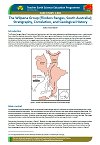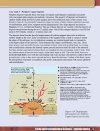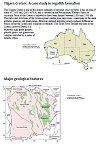Call for Case Studies to complement the ESWA Earth & Environmental Science textbook
and other EES texts
TESEP is seeking your assistance.
We are collaborating with Earth Science Western Australia (ESWA) to produce case studies that complement their fantastic Earth and Environmental Science (EES) text book. Download published Case Studies here!
By generating Australia-wide examples, our Case Studies will more effectively help all Australian teachers when the new Australian Curriculum EES course for years 11-12 is implementeed no matter which texy book they use.
The ESWA EES textbook has 19 chapters and we are looking for excellent Australian examples to support many areas of text. Each case study will consist of 2 to 6 pages, including an overview of relevant research, clear easy to read diagrams, uncluttered maps and relevant activities written for easy comprehension by senior high school students. The chapters address minerals, fossils, geological time, plate tectonics, geohazards, energy, resources and the 3 rock types but also embrace soils, water, weather, climate change, human activity, ecosystems and biodiversity. A complete overview with some possible case studies is listed below.
However, we are not seeking to rewrite the curriculum! You may think there are sections of the ESWA EES book missing but it is written to meet the WA EES curriculum requirements. New editions will also meet the national EES curriculum even better however no textbook can cover all possible content. Consequently, if you think you have material that does not fit the ESWA EES chapter headings do not be discouraged. The content touched upon under those headings is wide ranging and many less obvious connections can be made as a result.
If you have anything of your own or are aware of materials that might suit our needs please contact me as soon as possible. Obviously, we need to be sure that there are no copyright restrictions on the materials you provide, but even if you just have one classic photo of a particular geological phenomenon that you are willing to send, the Australian teaching fraternity and all future students will be very grateful and your contribution will be acknowledged.
TESEP will collaborate with you if you would like to write the entire document and format it to suit our template or we will accept your materials and synthesis them in consultation with you to produce the desired outcome. Either way the end result should be a 2 to 6 page document that focuses on an Australian example to provided students with a consolidation of their understanding as well as extra depth in the resources and activities they have access to.
Needless to say, in order to ensure national appeal the case studies will need to have national geographic spread so we are interested in material that relates to any place in Australia. The Case Studies will be delivered on-line as PDFs so we should be able to continually add them to the ESWA and TESEP websites as they are written up and inform teachers by email and newsletters.
In summary:
Each Case Study should:
- focus on one aspect of Earth Science relevant to an ESWA-EES text book chapter
- connect with at least one learning objective of the senior EES national curriculum
- be self contained, easy to read and easy to comprehend
- be no longer than 6 typeset pages of text, diagrams and tables
- contain one or more relevant, easy to implement, student activity
- list sources and references
- be free of copyright restrictions
- be bundled with at least one relevant student activity
TESEP will accept Case Studies (that meet the requirements above):
- after an internal review process to evaluate each proposal for suitability and need
- as raw text and supporting graphics that we have permission to edit and format
- as text and graphics that we will format in collaboration with the author
- as text and graphics formatted by the author under TESEP guidance
If requested, once publication ready, TESEP will:
- pay author-developers a maximum of $600 per fully realised and formatted case-study
- pay author-developers a maximum of $200 per case-study provided as raw text and graphics
More information for authors is available here including a Case Study proposal proforma, a document summarising the national and WA curriculum documents and a first draft proforma.
Please contact This email address is being protected from spambots. You need JavaScript enabled to view it., TESEP Executive Officer, to discuss useful material you may have or your interest in working up a case study you are familiar with.
ESWA EES textbook chapter headings and some suggestions for case studies
1. Introduction
- Earth Systems Science - Dry Land Salinity
- The Scientific Method - Discovery of Cadia
- Aboriginal astronomy - Emu constellation
- Aboriginal perspectives
- Communicating Science - Iodised salt
2. Our Place in Space
- Apophis - Near-Earth asteroid
- Mars landing site selection
- Titan - An alien Earth
- Martian meteorites
- Kepler mission - Planet hunting
3. Minerals
- Lake Eyre - Evaporates
- Broken Hill - Secondary minerals
- Warrumbungles - Zeoloites
- Broken Hill - Pegmatite minerals
- Australian Opal - overview
- Sapphire & Ruby - eastern Aust. overview
- Clays - Spectral Mineralogy
4. Igneous Rocks
- Cradle Mountain - Dolerite Sill
- Western victoria - Basalt Structures
- North Queensland - Tin & tungsten granites
- Tower Hill - Maar events
- Granite - S & I type
5. Sedimentary Rocks
- Lachlan Fold Belt Turbidites
- Charters Towers Devonian Limestone
- Bowen Basin Coal measures
- Flinders Ranges sedimentology
6. Metamorphic Rocks
- Mt Garnet Skarn v Contact Metamorphic
- Broken Hill Regional metamorphics
- East coast granite contact metamorphism
- Sedimentary Basin Diagenesis
- NE Tasmania - Mathinna Group
7. Weathering and Soils
- NSW coast - Acid sulphate soils
- Weipa - Bauxite
- Hobart - Dolerite weathering
- Wineglass Bay - Granite sand transport
- Chillagoe - Karst formation
- NSW highlands - Granite landscapes
8. Water
- Botany Bay Groundwater pollution
- Snowy River - Impact of dams
- Murray/Darling System - Irrigation
- Boorowa NSW - Dryland salinity
9. Weather and Climate
- Tropical cyclone - Yasi impacts
- Simpson desert - Gibber pavements
- The big dry - BoM data analysis
- Burdekin river coral - Wet season records
10. Climate Change
- Bowen Basin - Permian cold
- Lake Mungo
- Mt Lofty Ranges - Permian glaciation
- Climate proxies in sedimentary rocks
- Tasmania - Sea level rise
- Snowball Earth and Australia
- Australia - Fire tolerant vegetation
11. Volcanic Activity
- Warrumbungles - plugs & dykes
- Mount Warning - Caldera
- Undara Volcanic NP - Lava Tubes
- Western Victoria - Flood basalts
12. Earthquakes
- Newcastle - event analysis
- The Australian Tsunami Warning System
- Intraplate activity - Sutton
- Nuclear non-proliferation - Australia's role
13. Plate Tectonics
- Palaeo wander curve - Australian viewpoint
- Plate Tectonics - Australian Sth Margin
- Plate Tectonics - Tasman Sea
- Great Dividing Range - Landscape evolution
- Exploration - Cadia discovery
14. Ecosystems
- Macquarie wetlands - Aquatic birds
- Mound springs - Extremophiles
- Cave troglodytes - Glow worms
- Soft corals - Temperate waters
15. Human Activity and Biodiversity
- Victoria - Bushfire ecology & people
- North Queensland - GBR & farming
- Port Phillip Bay - Shipping lanes
- Jervis Bay - Seagrass meadows
- Aust. East coast - Invasive seaweed
- Tasmania - Old growth forests & logging
16. Fossils and Evolution
- Canowindra - Devonian fossil fish deposit
- Victoria - Graptolites
- Bowen Basin - Invertebrates Permian
- Naracoorte Caves - Megafauna
- Gogo Devonian fossil fish
- Polar Australian Dinosaurs
17. Geological Time
- Graptolites - Ordovician of Victoria
- Zircons - dating of uplift
- SHRIMP - Dating rocks
18. Energy Resources
- Geothermal - Australian potential
- Brown Coal - LaTrobe Valley
- Gas - Cooper Basin
- Hydroelectricity - Snowy Scheme
19. Mineral Resources
- Gold - Cadia
- Refractories - Broken Hill feldspar
- Copper - Mt Isa
- Victorian gold
- Dimension stone - Parliament House
NB: these suggested areas for Case Study are just that. There will be many others just as useful and if you have one let us know!
- Suggestions in blue are in progress
- Suggestions in orange are in draft
- Completed Case Studies can downloaded here
Science as a Human Endeavour
In addition to content orientated Case Studies we have had offers of material that address the Science as a Human Endeavour strand. While not a priority for this project this material is most welcome and all proposals will be evaluated and worked up where appropriate.
What is geological mapping?
How does exploration lead to a mine?
Creating SHRIMP
Geological history from an outcrop
Tunnel boring and geo-steering
Why S & I type?
Since this is an open ended project, you are welcome to propose a time line for your Case Study development which will be examined favourably as long as the proposals meet the Case Study needs as outlined above.
Example appearance of a case study
This is an example of a fully realised Case Study (2.05 Mb pdf). It has a single point of focus, it explains the issues in plain English, it has good graphics and it has a useful student activity included.
This is an example of the easy to read and understand style that we seek and the associated diagram a good example of an uncluttered and easy to comprehend graphic.
This is a 2 page pdf taken from the textbook (page 77 and 78 of edition 2) and contains a brief look at Porphyry style copper mineralisation in igneous rocks and a brief look at hydrothermal gold vein deposits in the eastern goldfields. While excellent in the context of the textbook, neither of these 'case studies' examine the topics in enough depth to provide the additional knowledge, resources and activities that would enable the further consolidation of student understanding that we seek with the proposed case studies. A 2 to 6 page document that focuses on an Australian example of Porphyry style copper mineralistion, complete with an overview of relevant research, clear easy to read diagrams, uncluttered maps and relevant activities is what is required. However, it is also essential that it is written for easy comprehension by senior high school students and teachers whose Earth Science knowledge may also be limited.
This is an example of the easy to read and understand style that we seek and the associated diagrams a good example of uncluttered and easy to comprehend graphics although extra editing would see them simplified further where possible.
At 9 A4 pages this document is too long although good overall graphic design could reduce this to 6 pages. However, with no associated activities and some text in need of further explanation extra editing is required before this case study could be considered fully realised for this project.


